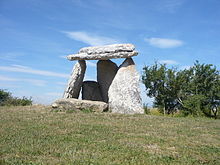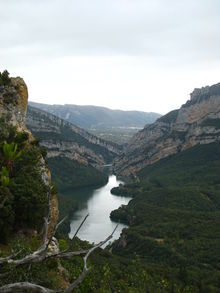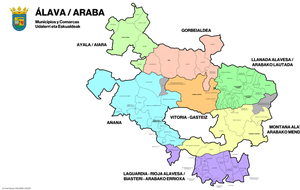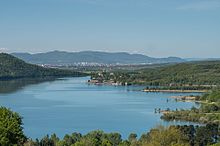Alava
Álava (in Basque, Araba; officially, Araba/Álava) is a Spanish historical territory and one of the three provinces that make up the autonomous community of the Basque Country. Its capital and most populated city is Vitoria, which is also the seat of the institutions of the autonomous community. It has an area of 3,037 km² (according to the INE), being the largest of the three Basque provinces. In 2022 it had a population of 334,412 inhabitants (INE), occupying 36th place among the Spanish provinces and the last place among those of the autonomous community. The small Burgos enclave of Treviño is located in the south of the Alava territory. Its council is one of the provincial councils with a foral regime; which has greater powers and political institutions differentiated from the rest of the councils. It is a forged territory.
Toponymy
Despite the fact that both forms, Álava and Araba are Basque, according to the autonomous legislation of the Basque Country, the official name of Álava, as a historical territory, is bilingual:
- Arab is the official denomination in Basque.
- Álava is the official denomination in Spanish.
In June 2011, the budget agreement reached between the PSOE and the PNV in the Congress of Deputies included the change of the official name of the province, through which the official name would be Araba/Álava .
History
Álava was inhabited in pre-Roman times by Autrigones, Caristios, Várdulos and Berones. The important sites found both in the northernmost part (Aloria) and in the central part (Iruña-Veleia, Arkaia, San Román) —through which the Ab Asturica Burdigalam road (from Astorga to Bordeaux)— belong to Roman times— and in the south (Campezo). The first written reference to this name appears in the IX century, in the chronicle of Sebastián, from the time of the Asturian-Leonese monarch Alfonso III.
In the opinion of the late Alava linguist Henrike Knörr, its name in Basque comes from alaba, derived from lau, 'plain,', plus the article, as stated on the website of the Provincial Council. Other theories defend the Romance origin of Álava linked to the place name "Alba". Some other proposals suggest that its origin has to do with the patronymic «Guevara», emphasizing that some Arab sources refer to the Llanada as Al-guebala, although Arab chroniclers tend to use the expression Alaba wa-l- Qila "Álava and the castles", probably understanding Álava not as the current province, but just the plain. In Basque it has also been called Araba-herria or Alaba-herria (form used by Axular).
Muslim Razias
The Muslim attacks against Álava were very numerous, being perhaps the region that suffered the most raids in the entire peninsula.
In the year 767, with Abderramán I, according to the Arab chronicles, there was an expedition against Álava commanded by Bedr, starting, like most, from La Rioja, and entered through Pancorbo and the Miranda plain. In the year 791, with Hixem I, the Muslim army under the command of General Ubayd Allah ben Uthmán. In the year 792, Alfonso II of Asturias had just risen to the throne, this time the Muslims under the command of General Abd al-Málik ben Mugith, looted the entire Llanada. In 794, the Muslims attacked led by Abd al-Karim, but were later defeated by Alfonso II in Lutos, in Asturias. In 796, there is another attack, organized by the late Hixem I.
In 801, led by Prince Moawia, brother of the emir, attacking Álava and Castilla, but the Muslim army fell defeated in a gorge near Miranda, in an ambush prepared by the Alava; It is the battle of La Puebla de Arganzón. In 803 Álava and Castilla received another attack by the army led by one of the Ben Mugith brothers; There are few sources of this attack and it may have been a failure, in the Wadi-Aroun, quite possibly the Oron River.
After a few years of calm, after Alhakén I died, Abderramán II came to power, carrying out the most violent attack recorded in Álava, according to Arab sources, which indicate that they entered through a gorge called Guerniq, behind which there was a plain where the enemy had their stores and provisions. The Arab troops fell on those plains and took them, seizing all the provisions. All those places were found deserted by the flight of their inhabitants. The raid was carried out in the summer of 822. 'Abd al-Karim invades the lands of Álava, looting them. After receiving a promise of submission from the Castilians and Alava, 'Abd al-Karim returned to Córdoba taking numerous hostages as security. This terrible expedition affected almost only the Álava region.
Another expedition against Álava is reported by the Arab historian Ibn Hayyan. It tells that in the year 825 a Cordovan troop led by Ubayd Allah, with the collaboration of the Basques of Pamplona, allies of the emir at the time, penetrated the Alava plains in August, reaching the "mount of the Madchus or fire worshipers". », where after hard fighting they destroyed the Christian forces. Those mountains that blocked their way could well be the mountains that go from Gorbea to the Aitzgorri massif. In the year 838, led by Prince Said, and in 839 by Musa ibn Musa. The last raid against Álava during the reign of Alfonso II was in the summer of 842, the year of the death of this Asturian king.
During the reign of Ordoño I of Asturias, around the year 854, there could have been another raid against Álava, but there are not many details about it. In the year 863, in which an army led by General Abd al-Málik ibn al-Abbás invaded, razed and put the Álava area to the sword. In the year 867 the prince Al-Hakkam will attack again, occupying the castle of Guerniq (or Yarniq), the same one from the campaign of 823. The real location of the castle is disputed, whether in the area of the current port of Azáceta or in an area between Etxabarri-Ibiña and Miñano Mayor, called Guernika. In the year 882 the Cordovan army falls on Álava starting from La Rioja. The Muslims tried to enter through Castro Cellorigo but were rejected by Count Vela Jiménez, second Count of Álava; shortly after they tried it for Pancorbo and failed equally. In 883, the result of the previous year is repeated, with the same contenders. It is the last year of the cyclical raids. Álava got rid of the constant raids, except for the one in Almanzor in the year 1000, when the border descended with the reconquests and repopulations, in the time of King Alfonso III of Asturias.
Middle Ages
In the 8th century the territory of Álava was already in the orbit of the Asturian kingdom since the reign of Fruela I of Asturias, but it would be in the IX century when the Asturian monarchy organized Álava under the political form of county, which would not disappear until the end of the XII century when Sancho VI of Navarre launched initiatives to introduce new forms of legal and political organization into the Alava territory, granting privileges to towns like Vitoria.
Between the centuries IX and XI the territory that Álava covers today formed part of the County of Castilla, which belonged to the kingdom of León until the year (in 932 AD, in which Castilla became independent to later form the Kingdom of Castilla (circa 1065). Álava briefly joined Castile when, taking advantage of the succession problems, a local nobleman named Eglyón or Elyón revolted to take advantage of the situation. Rodrigo de Castilla, the first count of Castile was in charge of putting down the rebellion that seemed to end (867 or 868) without even drawing his sword. This could be the reason why from that moment Count Rodrigo will also extend his dominions over Álava. Although his name still does not appear in the signed documents in the domains of the bishopric of Valpuesta, it does appear in a donation document from Obarenes (870) and in a letter from the Álava monastery of San Millán de Salcedo (April 18, 873), in the Cuartango valley together with Mr. Sarracín Muñoz, who could be Rodrigo's lieutenant in Álava lands.
Fernán González, at the end of the century X becomes Count of Castilla, Burgos, Álava, Lantarón and Cerezo (c. 931-944) unifying the territories and achieving the autonomy of the County of Castilla, also existing to the west of the current territory of Alava the County of Lantarón. During most of the XII century, the county of Álava was linked to the Kingdom of Navarre, but in 1199 King Sancho VII de Navarra loses Vitoria and most of Álava in favor of the Castilian king Alfonso VIII of Castile. In the context of the war between Castile and Navarre, the Arriaga Brotherhood would end up "voluntarily surrendering" to Castile. The Rioja Alavesa, centered around the town of Laguardia, would continue to form part of the Kingdom of Navarre until the end of the XV century, moment in which, within the framework of the Civil War in Navarra, Castilla conquered the territory of the Sonsierra de Navarra, becoming practically integrated in its entirety in Álava.
The precedents in the province of Álava occurred through two brotherhoods promoted by Vitoria within the Crown of Castile. In 1296 the Brotherhood of Haro, Vitoria promoted it together with the current Cuadrilla de Añana, Cuadrilla de Campezo-Montaña Alavesa, Cuadrilla de Laguardia-Rioja Alavesa, Cuadrilla de Salvatierra, enclave of Treviño, Miranda de Ebro and the regions of Rioja Alta and Rioja Media. Not so Zuya or Ayala. The Brotherhood of Álava was founded on October 4, 1463 in Rivabellosa (Álava). The towns of Vitoria, Miranda de Ebro, Salvatierra, Pancorbo and Sajazarra were integrated into it; 26 local brotherhoods and 2 boards, that of San Millán and Arana.
Contemporary Age
The province is known for the battle of Vitoria, within the Spanish War of Independence, against the French invasion of the country commanded by Napoleon Bonaparte. After the restoration of the Bourbon monarchy in Spain, clashes between the liberals and the Carlist began, giving rise to the Carlist Wars. During this XIX century there were two liberals from Alava who came to preside over the Government of Spain, Salustiano Olózaga and Miguel Ricardo de Álava.
Geography
The main peaks of Álava are Gorbea, with 1482 m a.s.l. no. m. (shared summit with Vizcaya); the Aratz, with 1443 m s. no. m.; the Palomares, with 1436 m a.s.l. no. m. and the Sierra de Toloño, with 1271 m a.s.l. no. m.. The main rivers that flow totally or partially through Álava are the Zadorra, the Bayas, the Nervión, the Ayuda, the Omecillo, the Ega, the Ebro and the Inglares.
Provincial boundary
Government and administration
Álava, like the rest of the provinces that make up the Basque Country, is a historical territory that counts as its own foral institutions the Provincial Council of Álava and the General Assemblies of Álava.
The Provincial Council is the provincial government and administration body that, on the one hand, performs the functions that the provincial councils perform in the rest of the Spanish provinces and that, on the other, is also the repository of specific powers (roads, social services, mignon, etc.) derived from the historical rights recognized in Álava and the other chartered territories. Among these foral powers, the administration of the own tax system acquires special relevance, which, in its current form, dates from 1876 when the central government abolished the foral system of the Basque provinces, but starting almost at the same time the economic concert system by which the Provincial Council collects the taxes from the people of Álava, later making a contribution to the State and the Basque Country to contribute to the common expenses of the national government and that of the autonomous community. The Provincial Council, as a collegiate body with executive powers, is headed by the Deputy General, a position currently held by Ramiro González Vicente (PNV).
The General Meetings of Álava are the institution that has been attributed the normative power of the first order in Álava through the approval of «foral regulations». They are made up of 51 representatives called procuradores or junteros, who are elected in the foral elections held simultaneously with the municipal elections in Spain. They function as a true provincial parliament that elects the Deputy General, approves the budgets and controls the activity of the Álava foral executive. At present, the president of the General Meetings of Álava is the attorney of the PNV Pedro Elósegui González de Gamarra.
| Elections to the 2019 General Boards | ||||
| Political party | Scalls | |||
|---|---|---|---|---|
| Basque Nationalist Party | ||||
| EH Bildu | ||||
| Euskadi Socialist Party - Euskadiko Ezkerra | ||||
| Popular Party of the Basque Country | ||||
| We can. | ||||
- Indebtedness of the Alava Provincial Council
As of December 31, 2008, the debt incurred by the Provincial Council of Álava amounted to 76 million euros, according to figures published by the Ministry of Economy and Finance. One year later (December 31, 2009), this figure had increased to 180 million euros, that is, more than 236% compared to the previous year. Finally, according to the latest available data (December 31, 2010), the debt continued to rise until it reached 338 million euros, that is, more than 187% compared to the end of 2009, and a cumulative 444% since December 2008. In other words, the debt in two years has multiplied by 4.5 times, reaching more than 1000 euros for each resident from Alava.
In comparison, the Provincial Council of Guipúzcoa, incurred a debt of 285 million euros as of 12/31/2010, or 403 euros per inhabitant. As of 12/31/2010, the Provincial Council of Vizcaya incurs a debt of 949 million euros, or 823 euros per inhabitant.
Administrative division
The territory is divided into seven gangs, according to the saying "Seven gangs make Álava one" (Zazpi talde Araba Bat).
- Añana Cuadrilla
- Ayala Cuadrilla
- Cuadrilla de Campezo-Montaña Alavesa
- Laguardia-Rioja Alavesa Square
- Salvatierra Square
- Cuadrilla de Vitoria (coincide con el Ayuntamiento de Vitoria)
- Gorbeialdea Square
Demographics
The province of Álava, excluding its capital, Vitoria, has less than 80,000 inhabitants, close to 334,000 including the capital. There is a marked macrocephaly since more than 75% of the total population of the province resides in the city of Vitoria. Álava macrocephaly is the result of the scarcity of populations of a certain entity, with the exception of the Ayala Valley, with cities such as Llodio and Amurrio, both with more than 10,000 inhabitants.
Most of the population is concentrated in the central area of Álava due to the location of Vitoria in that part of the province surrounded by populations of some importance with which the 274,000 inhabitants. Municipalities such as Zuya, Cigoitia, Villarreal de Álava and Arrazua-Ubarrundia bordering the capital to the north and the towns of Salvatierra, Alegría de Álava and Iruña de Oca on the Madrid-Irún railway axis that connects them with the center of Vitoria are the most important in the central area. Álava is the province with the highest percentage of inhabitants concentrated in its capital (75.77%, compared to a state average of 31.96%).
The twenty most populated municipalities in Álava are those indicated in the following table. Data obtained from the National Institute of Statistics in 2017, with the official name of the municipality indicated by the INE:
| Position | Municipality | Population |
|---|---|---|
| 1. a | Vitoria | 249 136 |
| 2. a | Llodio | 18 205 |
| 3. a | Amurrio | 10 286 |
| 4. a | Salvatierra | 5018 |
| 5. a | Oyon | 3368 |
| 6. a | Iruña de Oca | 33 |
| 7. a | Ayala | 2967 |
| 8. a | Alegría de Álava | 2887 |
| 9. a | Zuya | 2313 |
| 10. a | Villarreal de Álava | 1869 |
| 11. a | Arceniega | 1831 |
| 12. a | Cigoitia | 1753 |
| 13. a | Asparaena | 1643 |
| 14. a | Laguardia | 1505 |
| 15. a | Aramayona | 1483 |
| 16. a | Labastida | 1445 |
| 17. a | Baja | 1374 |
| 18. a | Urcabustaiz | 1336 |
| 19. a | Oquendo | 1162 |
| 20. a | Campezo | 1040 |
| Graphic of demographic evolution of Álava between 1900 and 2018 |
 |
Source: Spanish National Statistical Institute - Graphical development by Wikipedia. |
| Graphic of demographic evolution of Álava between 2000 and 2015 |
 |
Source: Spanish National Statistical Institute - Graphical development by Wikipedia. |
Transportation
There are several intercity bus lines that run through the province and neighboring areas, most of which have the capital, Vitoria, as their starting point. They were launched in 2015 by the Álava Provincial Council through the Department of Road Infrastructures and Mobility.
North
- Line 1: Vitoria-Cigoitia
- Line 2: Vitoria-Aramayona
- Line 3: Aramayona-Mondragon (Guipúzcoa)
This
- Line 4: Vitoria-Narvaja
- Line 5: Vitoria-Alegría de Álava-Araya
- Line 6: Vitoria-Santa Cruz de Campezo-Estella (Navarra)
South
- Line 7: Vitoria-Ventas de Armentia (Condado de Treviño, Burgos)-Bernedo-Lagrán
- Line 8: Logroño (La Rioja)-Oyón-Laguardia
- Line 9: Vitoria-Logroño (La Rioja)
- Line 10: Logroño (La Rioja)-Haro (La Rioja)
- Line 11: Logroño (La Rioja)-Villabuena de Álava
- Line 12: Vitoria-Haro (La Rioja)
West
- Line 13: Vitoria-Nanclares de la Oca-Villanueva de Valdegovía-Bóveda
- Line 14: Vitoria-Murguía-Izarra
- Line 15: Vitoria-Amurrio-Llodio
- Line 16: Arceniega-Amurrio-Llodio-Oquendo
Payment with a discount is possible using the BAT card, which is the same one that can be used on urban buses and the Vitoria tram.
Culture
Parties
Its patron saint is San Prudencio, celebrated annually on April 28, and its patron saint is the Virgin of Estíbaliz, celebrated on the second Sunday of September.
Monuments and places of interest
- Vitoria
- Its capital, Vitoria, has a large number of monuments and places of interest, among which stands out the Cathedral of Santa Maria de Vitoria in the middle of the medieval quarter. It was also the European Green Capital (European Green Capital) 2012.
- Ayala Valley
- Historic Casco of Arceniega and Sanctuary of Our Lady of the Encina
- Murga Palace Tower in Ayala
- Quejana palatial-conventional complex in Ayala
- Sanctuary of Santa Maria del Yermo in Llodio
- Lamuza Palace in Llodio
- Zuya Square
- Gujuli Cascade in Urcabustaiz
- Nervous jump.
- Gorbea Natural Park
- Urrúnaga reservoir in Villarreal de Álava
- Zurbano Palace Set
- Salvatierra Square
- Castle and Guevara Palace
- Historic Helmet of Salvatierra and Sorginetxe
- Ullíbarri-Gamboa reservoir
- Sanctuary of Our Lady of Ayala in Alegría de Álava
- Larrea Palace in Argómaniz
- Medieval paintings of the churches of Alaiza and Gaceo in Iruraiz-Gauna
- Lazarraga Palace in Zalduendo de Álava
- Añana Cuadrilla
- Oppidum Roman of Iruña-Veleia in Villodas (Oca's Nail)
- Botanic Garden and ruins of the monastery of Santa Catalina de Badaya in Trespuentes (Iruña de Oca)
- Roman Salinas de Añana
- Torre de los Varona in Villanañe
- Torre de Orgaz and Torre del Condestable in Fontecha
- Natural park of Valderejo
- Medieval Villa of Armiñón
- Portilla Castle and Lanos Castle in the municipality of Zambrana
- Campezo Square - Alavesa Mountain
- Medieval Villa of Antoñana
- Medieval Villa of Bernedo
- Medieval Villa of Peñacerrada
- Izki Natural Park
- Laguardia - Rioja Alavesa
- Bodegas y Hotel Marqués del Riscal in Elciego
- Historic Helmet of Labastida
- Medieval villa of Salinillas de Buradón
- Historic Helmet of Laguardia
- Bodegas Ysios in Laguardia
- Poblado celtíbero de La Hoya in Laguardia
- Dólmen de La Hechicera en Elvillar
- Medieval Villa of Labraza
Contenido relacionado
12th century BC c.
1944
Schumann Declaration





















